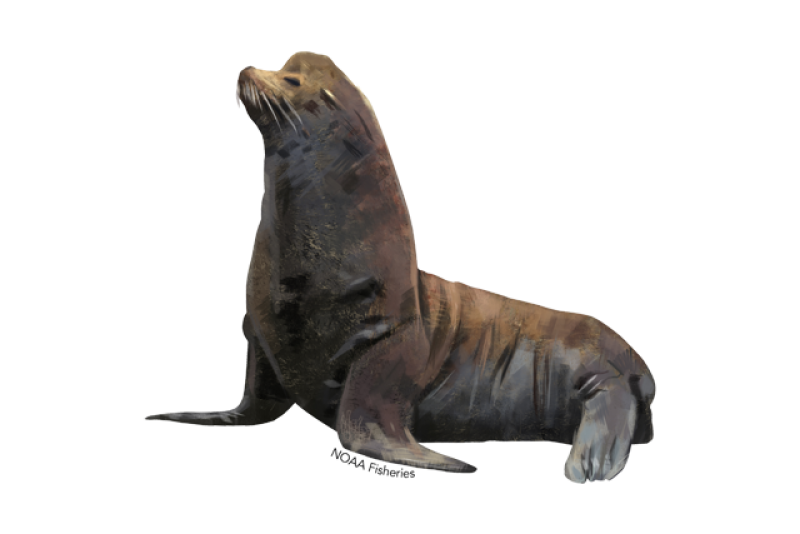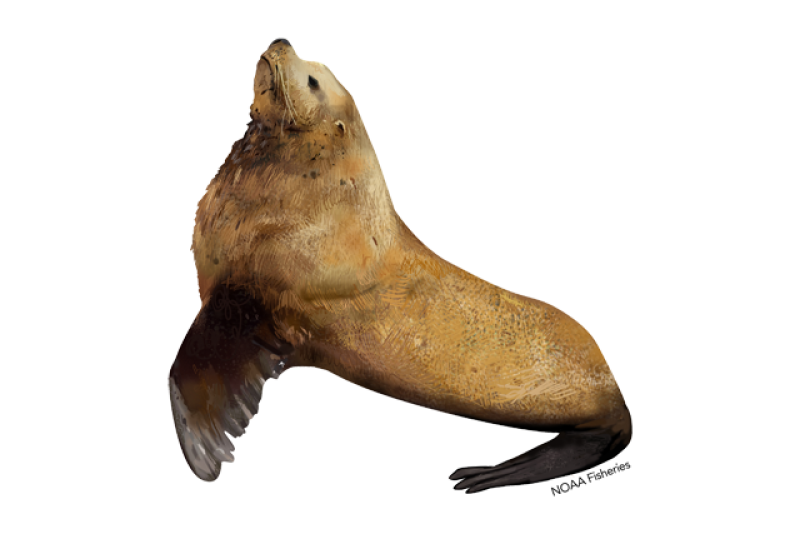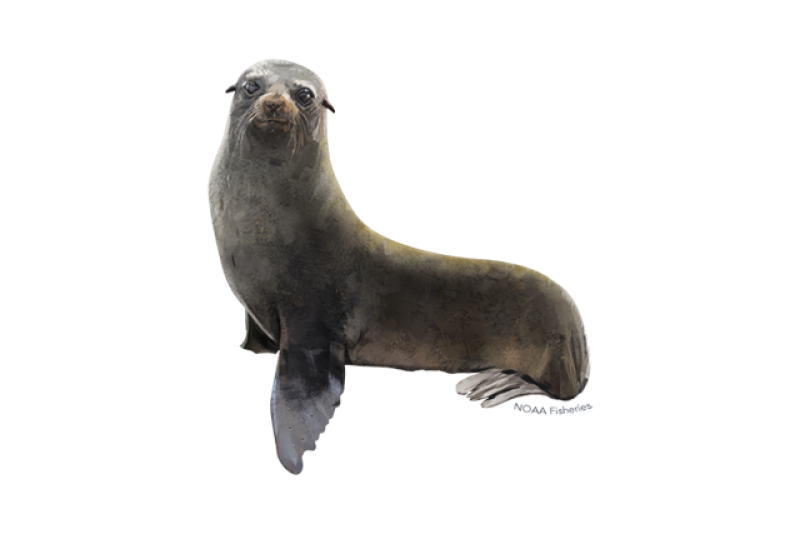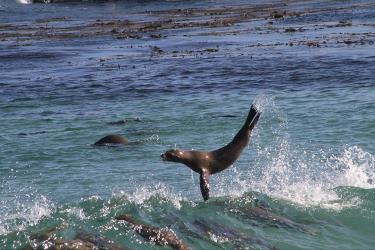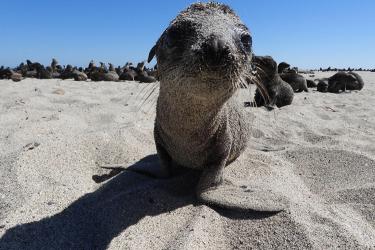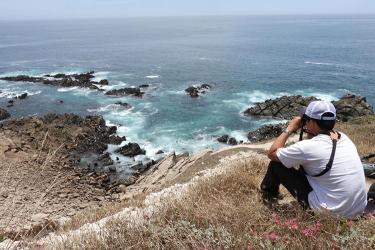Northern Fur Seal
Callorhinus ursinus
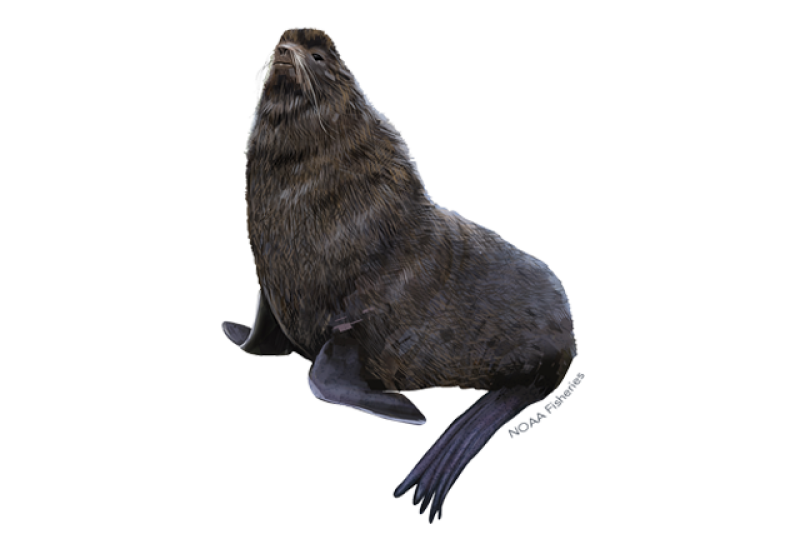
Protected Status
Quick Facts
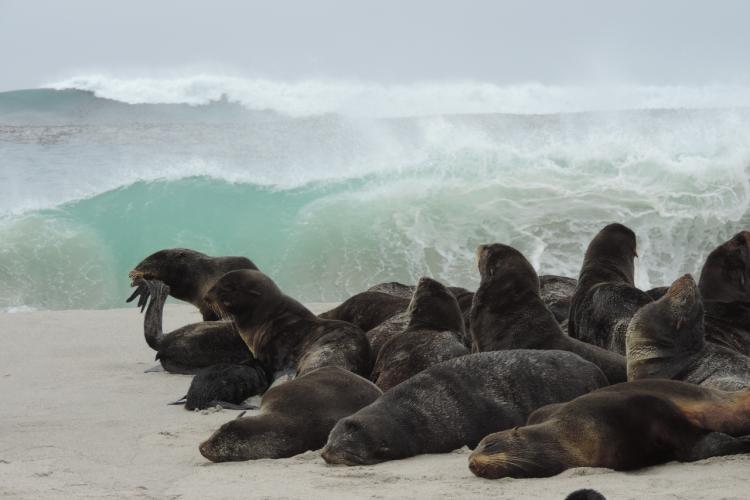 Northern fur seals haul out on San Miguel Island in the Channel Islands, California - Photo: NOAA Fisheries/Kristin Wilkinson, NMFS Stranding Coordinator
Northern fur seals haul out on San Miguel Island in the Channel Islands, California - Photo: NOAA Fisheries/Kristin Wilkinson, NMFS Stranding Coordinator
Northern fur seals haul out on San Miguel Island in the Channel Islands, California - Photo: NOAA Fisheries/Kristin Wilkinson, NMFS Stranding Coordinator
About the Species
 Northern fur seals haul out on San Miguel Island in the Channel Islands, California - Photo: NOAA Fisheries/Kristin Wilkinson, NMFS Stranding Coordinator
Northern fur seals haul out on San Miguel Island in the Channel Islands, California - Photo: NOAA Fisheries/Kristin Wilkinson, NMFS Stranding Coordinator
Northern fur seals haul out on San Miguel Island in the Channel Islands, California - Photo: NOAA Fisheries/Kristin Wilkinson, NMFS Stranding Coordinator
Northern fur seals are members of the "eared seal" family (Otariidae). They spend most of the year in the ocean. Weaned pups typically spend nearly 2 years at sea before returning to their breeding colonies. Northern fur seals forge at sea and use rocky or sandy beaches open ocean for foraging and rocky beaches for resting, molting, and reproduction.
Historically, northern fur seals were hunted for their fur on land and at sea. In 1911, the Fur Seal Treaty created an international prohibition on hunting fur seals at sea and a shared responsibility among the treaty nations for commercial harvests on land. In 1984, the United States ended commercial harvest of northern fur seals on the Pribilof Islands. Subsistence use is currently co-managed by NOAA Fisheries and the Tribal Governments of St. Paul and St. George Islands.
Northern fur seals, like all marine mammals, are protected under the Marine Mammal Protection Act (MMPA). The Pribilof Islands/Eastern Pacific stock is listed as depleted under the MMPA. The California Stock is not considered to be depleted under the MMPA or listed as threatened or endangered under the Endangered Species Act (ESA). In addition, northern fur seals are also protected under the Fur Seal Act.
NOAA Fisheries is committed to conserving and protecting northern fur seals. Our scientists and partners use a variety of innovative techniques to study, learn more about, and protect this species.
Population Status
In 1988, the Pribilof Islands population was designated as a depleted stock under the MMPA because it had declined by more than 50 percent from its estimated population of 2.2 million seals in the 1950s. This stock was reclassified in 1994 as the Eastern Pacific stock, which includes the Pribilof Islands population and a newly established breeding site on Bogoslof Island, and the California stock, which breeds on San Miguel and the Farallon Islands off the coast of California. The California Stock is significantly smaller than the Eastern Pacific stock. Estimated at 15,018 northern fur seals in 2022, it is smaller than the populations on St. Paul, St. George, or Bogoslof Islands. Trends in abundance since the designation of the Eastern Pacific stock are different for individual islands and even among breeding areas. Temporary increases in the overall stock size are observed when opportunistic estimates are conducted at Bogoslof Island, but declines at St. Paul Island continue to drive the overall stock estimate down over time. The annual pup production estimates for the Eastern Pacific stock have been declining at 1.80 percent per year from 1999 to 2019, but only at 0.55 percent (95% CI: -2.11 to 1.06; not significantly different from 0) per year from 2009 to 2019. The 2019 abundance estimate for the Eastern Pacific stock is 626,618.
Review northern fur seal stock assessment reports
The first northern fur seals to populate San Miguel Island migrated from the Pribilof and Russian islands, as individuals tagged on those locations were observed on San Miguel Island among breeding California sea lions. The population grew 46 percent in the 1950s and early 1960s but afterward experienced declines due to major El Niño events. The population began to recover in 1999, but it has been affected by subsequent El Niño events, often resulting in the deaths of all newborn pups. Additionally, hookworm disease has decreased pup survival and is a major factor affecting the population dynamics at its southernmost rookery. In 1996, a small population began breeding on South Farallon Island (off the California coast). Based on tag-resight information, it appears that the population originated from emigrants from the Pribilof and San Miguel Islands. The colony increased steadily from 1996 to the early 2000s, but it has grown exponentially during the past several years. Along with San Miguel Island it is part of the California stock.
Commercial sealing on the Commander Islands, Kuril Islands, and Tyuleny (previously Robben islands) in Asia caused a severe decline of northern fur seals in the early 1900s. The number of seals also declined on all three islands between the late 1960s and the late 1980s. The Robben Island population now appears to be recovering.
Appearance
Northern fur seals have a stocky body, small head, very short snout, and extremely dense fur (46,500 fibers/cm²) that ends at the wrist lines of their flippers. Their flippers are the longest in the Otariidae family. Their hind flippers can measure up to one-fourth of their total body length. Their fore flippers are incredibly strong, allowing them to walk or run on all fours. They can outrun a human on slippery rocks and can climb nearly vertical cliffs. Northern fur seals exhibit sexual dimorphism, which means that adult males are much larger (up to 370 percent) than adult females. Males can grow to 7 feet and weigh up to 600 pounds, whereas females can grow to 5 feet and weigh up to 120 pounds. At birth, pups weigh 3–4 pounds and are 12–14 inches long.
Adult males are dark brown to black, and adult females are dark gray or brown on their backs and light gray, silver, or cream on their throat, chest, and stomach. Pups are uniformly black until they molt when they are around 3 months old and they are a silver-gray color.
Northern fur seals have whiskers on their snout, known as vibrissae. Pups are born with black vibrissae. Their vibrissae grow throughout their lives and progressively turn white as they age, and adults have prominent white vibrissae.
Behavior and Diet
Northern fur seals are highly pelagic (live in the open ocean), and are thought to be mostly solitary at sea. They are known to be aggressive on land, especially during the breeding season. Adult males forcefully defend their breeding territory site. Male to male aggression is most frequently used in defense of territories and consists of pushing and biting, sometimes to the death. Males are sometimes aggressive to females if they try to leave the territories. Female to female aggression is frequent but mild (open mouth threat). Intense female to female aggression (biting and pushing) is rare.
Northern fur seals are described as generalist or opportunistic foragers, consuming a wide variety of midwater fish and squid species. Walleye pollock is the predominant prey of northern fur seals that forage over the Bering Sea shelf. They consume greater amounts of oceanic fish and squid species when they forage over the slope and in off-shelf waters. In north Pacific, primary prey include Pacific sand lance, Pacific herring, northern smoothtongue, Atka mackerel, and Pacific salmon. Off the West Coast, they feed on mackerel, octopus, squid, sardine, anchovy and a variety of myctophids. The northern fur seal diet differs depending on geographic area and time of year. Northern fur seal diet and tracking (telemetry) studies indicate they forage in colony-specific areas, while they use their preferred land sites for resting, reproduction, and rearing their young.
Where They Live
Northern fur seals primarily inhabit two types of habitat: open ocean and rocky or sandy beaches on islands for resting, reproduction, and molting.
Northern fur seals seasonally breed on six islands in the Eastern North Pacific Ocean and Bering Sea in the United States—St. Paul, Bogoslof, St. George, Sea Lion Rock, San Miguel, and Southeast Farallon. They also breed on the Commander Islands, Kuril Island, and Tyuleny Island in Russia.
The Pribilof Islands support the largest aggregation of northern fur seals(about half of the world's northern fur seal population), which breed on St. Paul Island, St. George Island, and Sea Lion Rock (off St. Paul Island). Non-breeding northern fur seals haul-out on Walrus Island and Otter Island which are also part of the Pribilof Islands.
Adult northern fur seals spend more than 300 days per year (about 80 percent of their time) at sea. During the summer and autumn they intermittently fast while on land and feed at sea. During the winter and spring they are pelagic, occupying the North Pacific Ocean as well as the Bering and Okhotsk Seas. In the open ocean, concentrations of northern fur seals may occur around oceanographic features—such as eddies, convergence-divergence zones, and frontal boundaries—because of the availability of prey in those places. In the winter, the southern boundary of the northern fur seal range extends across the Pacific Ocean, between southern California and Honshu Island, Japan, but they are found as far north as the Bering Sea. In the spring, most northern fur seals migrate north to breeding colonies in the Bering Sea. Territorial adult male northern fur seals leave their breeding colonies in August and are thought to spend most of their time in the Bering Sea and North Pacific Ocean along the Aleutian Islands. Pregnant adult females begin their winter migration in November and generally travel to either the central North Pacific Ocean or to offshore areas along the west coast of North America to feed. Some northern fur seals may spend all year in the waters around San Miguel Island, California.
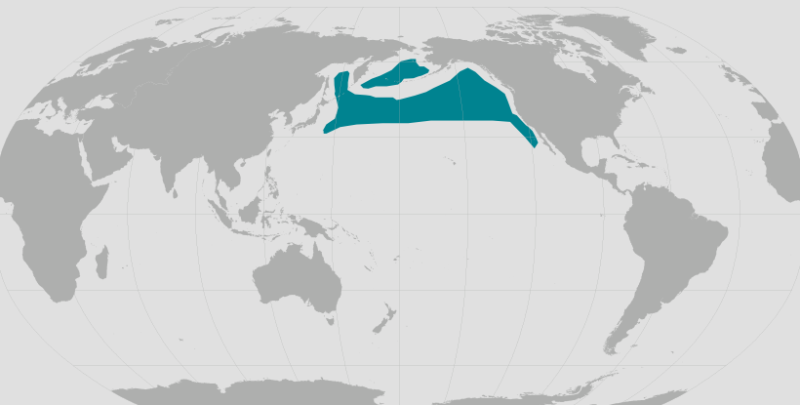 Northern Fur Seal Range Map
Northern Fur Seal Range Map
Lifespan & Reproduction
Male northern fur seals can live up to 18 years, whereas females can live up to 27 years. Beginning in May, male seals start returning to the breeding islands. Adult males, or bulls, arrive first to occupy and defend prime breeding territories before the females arrive. A male’s ability to mate depends on several factors, such as body size, fighting ability, size and location of the chosen breeding territory, and skill at interacting with females. Because males do not leave the breeding territory to feed, their ability to fast is critical. Males remain on their territory for an average of 46 days, losing 32 percent of their body mass. Breeding males are typically 10 or more years old and maintain females within their territories. About 30 percent of the adult males on land breed with females during the summer. Adult males are counted annually during the peak of the breeding season as an index of the population size. They are categorized as territorial with females, territorial without females, or non-territorial. Territorial males abandon their breeding sites in August, allowing non-territorial males to occupy these same sites, but the vast majority of adult females have already mated at this point. Adult males exclude juvenile males from the breeding areas. Juveniles instead congregate on land in areas called "haulouts" during the summer breeding season. The haulouts can be located inland, typically behind the breeding areas, or adjacent to the breeding areas. The typical structure of northern fur seal terrestrial habitat includes the central area occupied by breeding males with females, surrounded by territorial adult males without females on the fringe, non-territorial adult males, and juvenile males on haulouts outside the breeding areas.
Females generally have their first pup at 5 to 6 years of age and are in their reproductive prime between the ages of 8 and 13. They are not selective in their choice of mate, but they do show an affinity for a specific breeding site. Females typically start returning to the breeding islands in late June and give birth to a single pup 1.3 days after arrival on land. Mating occurs within 5.3 days of giving birth. Female northern fur seals undergo embryonic diapause (or delayed implantation), meaning the embryo does not immediately implant in the uterus and is thought to be delayed until after lactation, or weaning. Females nurse their newborn pups for 5 to 6 days and then go to sea to forage for 3.5 to 9.8 days. Females continue to cycle between land(to nurse) and sea(to forage) for the remainder of the nursing period. Their time on land declines to less than two days and their time at sea generally increases. Pups are nursed until weaning (about 4 months) and leave the breeding site before their mothers to forage independently for the first time.
Threats
Entanglement in Marine Debris and Lost or Abandoned Fishing Gear
Northern fur seals can become entangled in lost or abandoned fishing gear such as trawl webbing, packing bands and monofilament nets, or other marine debris, either swimming off with the gear attached or becoming anchored. Fur seals encounter marine debris at sea and on beaches.. Fur seals seasonally migrate, spending most of their time in the North Pacific Ocean foraging in the transition zone and spending time in eddies while migrating. These oceanographic features concentrate nutrients and prey, and also marine debris. They also encounter marine debris in the Bering Sea during their foraging trips to and from their breeding and resting areas on land or may encounter it on land where marine debris has accumulated on shore. Once entangled, seals may drag and swim with attached gear for long distances, ultimately resulting in fatigue, compromised feeding ability, or severe injury, which may lead to reduced reproductive success and death.
Effects of Fisheries on Prey
The type of available prey, access to prey, and distribution of prey can change for a variety of reasons. For example, regional and local prey can change because of changes in climate, oceanography, and the overall complexity of the oceans ecosystem. Cumulative and annual commercial fisheries removals may result in temporal and seasonal changes in distribution and abundance of primary prey, prey reduction, and changes in prey size; they may also cause ecosystem effects. All of these may affect fur seals’ ability to reliably access sufficient prey to sustain the health, reproduction, and survival of individuals and support sustained increase and eventual recovery of the population. Very few fur seals are observed captured in active fishing nets (i.e., bycatch). Indirect commercial fishery effects can include competition for commercial fish species.
Climate Change
Global climate change is expected to have profound impacts on arctic and sub-arctic marine ecosystems. This may affect the composition, spatial and temporal distribution, and abundance of prey available to fur seals.
Sea Level Rise
Sea level rise caused by climate change may directly alter access to or the utility of terrestrial rookery and haulout sites currently used by fur seals. Traditional sites on some islands with low relief may be submerged, but other habitats may become accessible.
Temperature Changes
Decadal-scale regime shifts, and shorter-term oceanographic anomalies such as El Niño Southern Oscillation (ENSO) and marine heatwaves events, also can have large effects on distribution, availability and abundance of fur seal prey. Marine heatwaves have already been shown to reduce fur seal survival.
Ocean Acidification
Ocean acidification effects on fur seals are uncertain but are likely to include serious impacts on ecosystems and may have adverse effects on specific species prey through food web effects.
Harmful Algal Blooms
Harmful algal bloom (HAB) toxins cause sickness and death in humans and fur seals by consuming contaminated food. Warming water temperatures increases toxic algae growth, prevents water from mixing, allowing algae to grow thicker and faster. Additionally, and algal blooms absorb sunlight, making water even warmer and promoting more blooms.
Environmental Contaminants
Contaminants can enter the ocean and subsequently affect the food chain of the northern fur seal. Contaminant studies on northern fur seals have shown exposure to various toxic substances and evidence of accumulation in various tissues. Contamination sources can include oil and gas development, industrial runoff, vessel discharge, microplastics, vessel grounding, and oil spills. These contaminants have the potential to affect the immune, digestive, or endocrine systems of northern fur seals, leaving them more susceptible to disease and reducing their survival and reproduction.
Predation
The killer whale is a primary predator of northern fur seals, but Steller sea lions are also known to prey on northern fur seals. Sharks may also prey on northern fur seals.
Other
Other threats include environmental changes, oil and gas exploration, habitat degradation, human presence, disturbance by marine vessels or aircraft, chronic pollution, and illegal harvests.
Scientific Classification
| Kingdom | Animalia | Phylum | Chordata | Class | Mammalia | Order | Carnivora | Family | Otariidae | Genus | Callorhinus | Species | ursinus |
|---|
Last updated by NOAA Fisheries on 04/28/2025
What We Do
Conservation & Management
NOAA Fisheries is committed to the protection and recovery of northern fur seals. We have directed our conservation efforts to the depleted population of the Pribilof Islands. To make informed management decisions, we use systematic and regularly collected population data. The management actions to protect and conserve northern fur seals, include:
- Regulating, monitoring, and co-managing subsistence use of northern fur seals.
- Monitoring population abundance and distribution.
- Managing and reporting incidental takes of northern fur seals in commercial fishing activities.
- Removing debris from entangled northern fur seals and their habitat.
- Minimizing the effects of harassment, disturbance, and other types of human and animal impacts.
- Reviewing projects that could harm northern fur seals or degrade their habitat.
- Educating the public about northern fur seals and the threats they face.
Science
Our research projects have led to discoveries of new aspects of northern fur seal biology, behavior, and ecology and in turn have helped us better understand the challenges that all fur seals face. This research is especially important in rebuilding depleted populations. Our work includes:
- Population assessments.
- Vital rate (survival and reproduction) studies.
- Foraging ecology studies.
- Diet studies.
- Health and condition studies.
- Disease and contaminants studies.
How You Can Help
Report Marine Life in Distress
In Alaska, report a sick, injured, entangled, stranded, or dead marine mammal to the Alaska Marine Mammal Stranding Hotline at (877) 925-7773 to make sure professional responders and scientists know about it and can take appropriate action. Numerous organizations around Alaska are trained to receive reports and respond when necessary.
On the west coast of the U.S., please contact the West Coast Region Stranding Hotline at (866) 767-6114.
Other reporting hotlines and resources:
- To report entangled marine mammals:
- Entanglement Reporting Hotline: 1-877-SOS-WHAL or 1-877-767-9425
- The U.S. Coast Guard: VHF Ch. 16
- To report derelict gear:
- Derelict Gear Hotline: 1-855-542-3935
- Regional stranding response contacts
Keep Your Distance
Be responsible when viewing marine life in the wild. Observe all seals and sea lions from a safe distance of at least 50 yards and limit your time spent observing to 30 minutes or less.
Report a Violation
Call the NOAA Fisheries Enforcement Hotline at (800) 853-1964 to report a federal marine resource violation. This hotline is available 24 hours a day, 7 days a week for anyone in the United States.
You may also contact your closest NOAA Office of Law Enforcement field office during regular business hours.
Featured News
 Dead Northern fur seal on St. Paul Island, Alaska. Credit: Paul Melovidov, Ecosystem Conservation Office Aleut Community of St. Paul Island (used with permission).
Dead Northern fur seal on St. Paul Island, Alaska. Credit: Paul Melovidov, Ecosystem Conservation Office Aleut Community of St. Paul Island (used with permission).
Harmful Algal Blooms Linked to Deaths of Northern Fur Seals in the Southeast Bering Sea
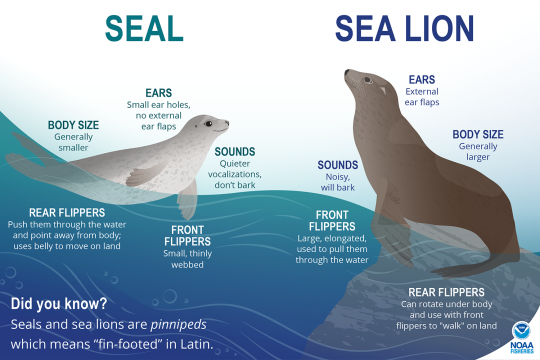 At first glance, seals (true or “earless seals”) and sea lions look fairly similar. Taking a closer look, these are some of the general differences to tell these animals, such as on the harbor seal (left) and California sea lion (right) pictured above.
At first glance, seals (true or “earless seals”) and sea lions look fairly similar. Taking a closer look, these are some of the general differences to tell these animals, such as on the harbor seal (left) and California sea lion (right) pictured above.
Is It a Seal or a Sea Lion?
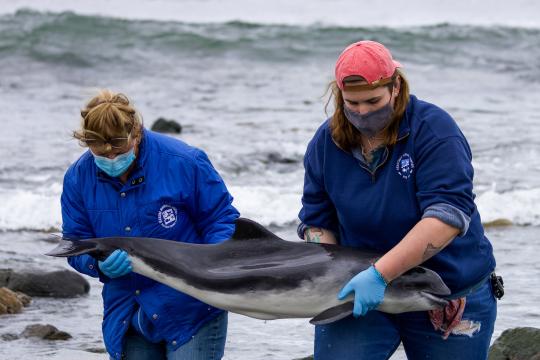 A harbor porpoise is retrieved from the rocks at Odiorne Point State Park, New Hampshire. Credit: Seacoast Science Center
A harbor porpoise is retrieved from the rocks at Odiorne Point State Park, New Hampshire. Credit: Seacoast Science Center
2020 and 2021 Combined Report of Marine Mammal Strandings in the United States
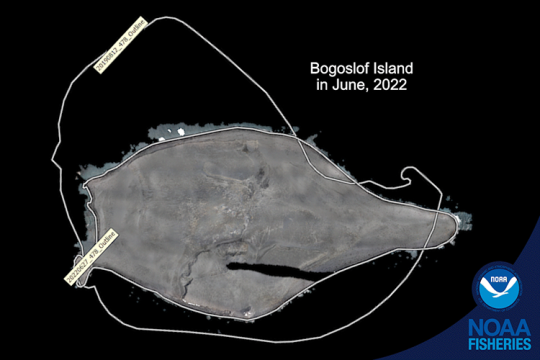 Aerial survey imagery from June 2022 along with a white outline showing the former size in 2019. Erosion has changed the island dramatically since it tripled in size after the eruptions in 2016-2017. Credit: NOAA Fisheries/Alexey Altukhov and Burlyn Birkemeier.
Aerial survey imagery from June 2022 along with a white outline showing the former size in 2019. Erosion has changed the island dramatically since it tripled in size after the eruptions in 2016-2017. Credit: NOAA Fisheries/Alexey Altukhov and Burlyn Birkemeier.
Northern fur seals were hunted and killed for their fur. Throughout history, there have been many treaties and management measures put into place to manage and protect this species.
Commercial Harvest History
Harvest management of northern fur seals on the Pribilof Islands has a long history, which began when Russians brought Aleuts to the islands as sealing crews in 1786. The Russians harvested about 3 million fur seals during their control of the Pribilof Islands. They also instituted the first fur seal research and harvest management measures in 1806, and in 1807, canceled the harvest. From 1822 to 1827, bulls and pups were not harvested, and by 1847 the Russians set up a "breeding reserve" to protect the females. The population increased due to these conservation measures.
After the sale of Alaska to the U.S. in 1867, commercial harvests continued, and generated large profits for fur merchants as well as tax revenues for the U.S. government. It has been estimated that by the early 1900's the tax and lease revenue, from the sale of Pribilof fur seal skins, paid for the 7.2 million dollar purchase of Alaska.
In 1869, the Pribilof Islands were set aside as a special reservation for the protection of fur seals and the U.S. Treasury was authorized to lease sealing privileges. The first 20-year lease of sealing privileges on the Pribilof Islands was issued to the Alaska Commercial Company and commenced in 1870 and the total harvest killed approximately 2,255,519 seals. A fierce dispute among countries began since sealing on land was now limited to a single company, and the remaining individuals and companies were only allowed to take seals at sea. A second 20-year lease of sealing privileges was issued to the North American Commercial Company.
Resolving years of international dispute about the United States’ jurisdiction over the nearshore marine waters, northern fur seals were given protection from all pelagic sealing with the signing of the North Pacific Fur Seal Treaty of 1911 (PDF, 10 pages) by Great Britain, Japan, Russia and the United States. The Treaty prohibited pelagic sealing by all countries, and established the U.S. to operate all land harvest activities and split the skins obtained among the signatory countries. The Treaty remained in force until 1941. A successive convention was signed in 1957 and amended by a protocol in 1963. The international convention was put into effect domestically by The Fur Seal Act of 1966.
After the early years of indiscriminate fur seal harvesting, U.S. management of land-based commercial sealing restricted killing to non-breeding males on the haulouts during the summer. As a result, the population thrived and was estimated to number about 2.1 million seals on the Pribilof Islands in the 1950s. The Japanese threatened to abrogate the convention if the U.S. did not take action to reduce the herd over concern that their fisheries resources were being reduced by fur seals. As a result the U.S. began a herd reduction program which authorized killing female fur seals from 1956 through 1968. The commercial harvest continued on the Pribilof Islands reaching a peak of almost 96,000 juvenile male fur seals in 1956 in addition to almost 27,000 female fur seals. The highest quality and most valuable skins came from 2- to 4-year old male fur seals, this subgroup of juvenile or non-breeding males are referred to as sub-adult males and they became the focus of the commercial harvest by using size limits. The population declined as expected from the female killing, but continued to decline unexpectedly through the 1970s. In order to investigate the population effects of harvesting NOAA Fisheries discontinued harvests on St. George Island in 1973. NOAA set aside St. George Island as a research control site (i.e., no harvests) for scientific study under the convention, and St. Paul Island was the experimental site (i.e., continued harvests). The U.S. did not sign the Interim Convention on the Conservation of North Pacific Fur Seals in 1984, which led to the cessation of commercial harvesting on St. Paul Island. A subsistence harvest of subadult male fur seals has continued on both islands under the authority of the Fur Seal Act since 1985. The subsistence harvest is limited to fewer than 2,500 subadult male seals a year.
Last updated by NOAA Fisheries on 04/28/2025
Management Overview
The northern fur seal is protected throughout its range under the Marine Mammal Protection Act. This population was reclassified as the Eastern Pacific stock in the 1990s, which also includes fur seals breeding on Bogoslof Island.
Scientists with NOAA Fisheries Marine Mammal Laboratory have been collecting population data on St. Paul and St. George Island (Pribilof Islands) to evaluate the trends and status of the northern fur seals since the early 1900s. This includes monitoring subsistence harvests, assessing possible adverse effects of human-related activities on or near the Pribilof Islands, and conducting research and analyzing data to determine the cause of population changes in the Pribilof Islands’ northern fur seal population. NOAA Fisheries managers in collaboration with Tribal co-managers have also created a conservation plan with the goal of to increasing the population of northern fur seals to a level where it is no longer considered depleted under the MMPA.
Co-Management Agreements
In 1994, the MMPA was amended to include section 119, which reads, "The Secretary may enter into cooperative agreements with Alaska Native Organizations to conserve marine mammals and provide co-management of subsistence use by Alaska Natives." NOAA managers and local tribes pursued a more active harvest management and monitoring role for local tribal members from 1994 to 2001. As a result, NOAA Fisheries and the tribal Government of both St. Paul Island and St. George Island had already been co-managing subsistence use of northern fur seals before signing their co-management agreements in 2000 and 2001, respectively. In 2019, NOAA Fisheries and the Aleut Community of St. Paul Island revised their co-management agreement to reflect changes in the subsistence use regulations and increase cooperative management of subsistence use.
Conservation Efforts
Managing Subsistence Harvest
NOAA Fisheries issued an emergency interim rule in 1985, followed by a final rule in 1986, to initiate a subsistence harvest of northern fur seals by Alaska Natives on the Pribilof Islands. The subsistence harvest is regulated under the authority of section 105(a) of the Fur Seal Act. Under co-management agreement with NOAA Fisheries, the tribal Governments of St. Paul and St. George have a formal role in managing the harvest of northern fur seals to meet their subsistence needs; the commercial harvest for fur had always exceeded the subsistence need for meat on the Pribilof Islands. Fewer than 1,000 juvenile male northern fur seals have been harvested annually since 2000. In 2014, NOAA Fisheries again revised the subsistence harvest regulations to allow residents of St. George to harvest pups to meet their subsistence needs. In 2019, NOAA Fisheries revised the subsistence regulations by eliminating several duplicative and unnecessary regulations, creating annual subsistence limits, and increasing opportunities for cooperative management and monitoring of subsistence use.
The Tribal governments of St. George and St. Paul share responsibility with NOAA Fisheries to cooperatively manage, monitor, and report their subsistence use of marine mammals.
Learn more about how we monitor and report subsistence harvests
Reducing Entanglement in Marine Debris
NOAA Fisheries Alaska Region, NOAA Fisheries Marine Mammal Laboratory, and Tribal Governments have conducted disentanglement studies on the Pribilof Islands. These studies provide entanglement estimates and remove debris from captured animals. In addition to directed studies of entanglement, individual disentanglement responses occur frequently every year.
The Tribal Governments of St. Paul and St. George and the NOAA Marine Debris Program have coordinated annual beach cleanup and derelict fishing debris removal at select locations on the Pribilof Islands.
Learn more about our work to reduce northern fur seal entanglement
Developing Oil Spill Contingency Plans
NOAA cooperated with numerous agencies to develop an area oil spill contingency plan that has been in effect for over 20 years. The Pribilof Islands Wildlife Protection Guidelines (PDF, 153 pages) were developed specifically to address the high density and sensitivity of fur seals to an oil spill near the Pribilof Islands The Alaska Regional Response Team plan is reviewed and updated as needed to ensure its applicability to ever-changing oil spill risks and to integrate experience gained from oil response in other regions. As part of the plan, state, federal, and local agencies identified sensitive habitats in the Pribilof wildlife protection guidelines, response strategies for particular species, and maps of those sensitive wildlife areas.
Monitoring Domestic Fisheries
NOAA monitors domestic fisheries through an observer program that identifies sources of mortality for marine mammals, including northern fur seals. Fisheries observer program biologists placed on fishing vessels record fishing efforts (e.g., number of sets, size of nets, time and location of sets) and bycatch of non-target species. They also document the number, sex, and age of all marine mammals observed and caught. NOAA Fisheries then summarizes the observers incidental take data and makes serious injury and mortality determinations as necessary in its annual stock assessment reports.
Reviewing Proposed State and Federal Permits, Environmental Analysis, and Identifying Mitigation Measures
Under the Marine Mammal Protection Act and Fur Seal Act, NOAA regularly reviews proposed state and federal permits and actions that may affect northern fur seals. NOAA Fisheries works with agencies and applicants to determine whether such actions could harm northern fur seals or damage habitats essential to their survival and to identify measures to avoid or minimize possible adverse effects. We also review marine mammal research permits.
Overseeing Marine Mammal Health and Stranding Response
We work with volunteer networks in all coastal states to respond to marine mammal strandings including all pinnipeds. When stranded animals are found alive, NOAA Fisheries and our partners assess the animal’s health and determine the best course of action. When stranded animals are found dead, our scientists work to understand and investigate the cause of death. Although the cause often remains unknown, scientists can sometimes attribute strandings to disease, harmful algal blooms, vessel strikes, fishing gear entanglements, pollution exposure, and underwater noise. Some strandings can serve as indicators of ocean health, giving insight into larger environmental issues that may also have implications for human health and welfare.
Learn more about the Marine Mammal Health and Stranding Response Program
Marine Mammal Unusual Mortality Events
Northern Fur Seals have never been part of a declared unusual mortality event. Under the Marine Mammal Protection Act, an unusual mortality event is defined as "a stranding that is unexpected; involves a significant die-off of any marine mammal population; and demands immediate response." To understand the health of marine mammal populations, scientists study unusual mortality events.
Get information on active and past UMEs
Get an overview of marine mammal UMEs
Preventing Rats on the Pribilof Islands
The U.S. Fish and Wildlife Service, NOAA, The Tribal Governments of St. Paul and St. George and a variety of local community organizations and other federal agencies work collectively to prevent the introduction of rats onto the Pribilof Islands. Rats would rapidly devastate the abundant seabird populations and potentially introduce disease to marine mammals. Rat prevention training occurs periodically. Activities include setting up and regularly maintaining trapping stations, providing visitor education programs, identifying rat introduction risks, and establishing emergency response protocols.
Key Actions and Documents
Incidental Take Authorization: Scripps Institution of Oceanography's Geophysical Surveys in the Cascadia Subduction Zone of the Northeast Pacific
Incidental Take Authorization: U.S. Fish and Wildlife Service, Farallon Islands National Wildlife Refuge's Research, Monitoring, and Management
Incidental Take Authorization: City of Ketchikan's Berth III Mooring Dolphins Project in the Port of Ketchikan in the Tongass Narrows, Alaska
Incidental Take Authorization: United States Coast Guard's Base Kodiak Homeporting Facility in Kodiak, Alaska
More Information
Last updated by NOAA Fisheries on 04/28/2025
Science Overview
NOAA Fisheries conducts various research activities on the biology, behavior, and ecology of northern fur seals. The results of this research are used to inform management decisions for this species. Our work includes:
- Population assessments.
- Vital rate (survival and reproduction) studies.
- Foraging ecology studies
- Diet studies
- Disease and contaminants studies
Population/Stock Assessments
Determining the number of northern fur seals in each population—and whether a stock within the population is increasing or decreasing over time—helps resource managers assess the success of enacted conservation measures. Our scientists collect information and present these data in annual stock assessment reports.
Northern Fur Seals in Alaska and California

Our research on the population dynamics, biology, health, distribution, and movement patterns of northern fur seals provides information crucial for understanding and protecting fur seal populations in Alaska and California.
Learn more about Northern Fur Seal Research in Alaska and California
More Information
Recent Science Blogs
Last updated by NOAA Fisheries on 04/28/2025
Documents
Conservation Plan for the Eastern Pacific Stock of Northern Fur Seal (Laaqudax̂) (2024)
The 2023 draft conservation plan for northern fur seals has been finalized based on public comments
Conservation Plan (Draft) for the Eastern Pacific Stock of Northern Fur Seal, Callorhinus Ursinus (2023)
Revision of the 2007 conservation plan for northern fur seals (Callorhinus ursinus) to incorporate…
Subsistence Harvest of Steller Sea Lions and Sub-Adult Northern Fur Seals on St. Paul Island, Alaska
Subsistence harvest reports of Steller sea lions and sub-adult male fur seals on St. Paul Island,…
Co-Management Plan for Subsistence Use of Marine Mammals on St. Paul Island, Alaska
This plan represents a cooperative effort to identify, prioritize, and implement management…
Data & Maps
2022 Northern Fur Seal Pup Production Estimate and Adult Male Counts on the Pribilof Islands, Alaska
Northern fur seal pup estimates and Adult Male Counts on the Pribilof Islands, Alaska.
2021 Northern Fur Seal Pup Production And Adult Male Counts On The Pribilof Islands, Alaska
Northern fur seal pup and adult male counts.
2019 Northern Fur Seal Pup Production Estimate on Bogoslof Island, Alaska
Northern fur seal pup estimates
1980 Alaska Fur Seal Investigations
The northern fur seal (Callorhinus ursinus) is harvested commercially by the United States on St…
Research
Alaska Marine Mammal Field Work
NOAA Fisheries Alaska Fisheries Science Center and National Oceanic & Atmospheric Administration conduct research on marine mammals off the coasts of Alaska, Washington, Oregon, and California.
1998-2011 Alaska Northern Fur Seal Stock Assessments
The following represents Alaska's Northern fur seal stock assessment numbers from 1998-2011.
Alaska Fur Seal Investigations by Decade
The following represent Alaska fur seal numbers and investigations from 1944-2014.
Outreach & Education
Lesson 7-8, Grades 7-12: Northern Fur Seal Curriculum
Education materials for Grades 7-12.
Lesson 4-6, Grades 7-12: Northern Fur Seal Curriculum
Education materials for Grades 7-12.
Lesson 1-3, Grades 7-12: Northern Fur Seal Curriculum
Education materials for Grades 7-12.
Elementary: Northern Fur Seal Curriculum
The Northern Fur Seal curriculum for elementary grades K-6.
Last updated by NOAA Fisheries on 04/28/2025
